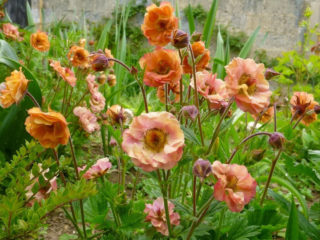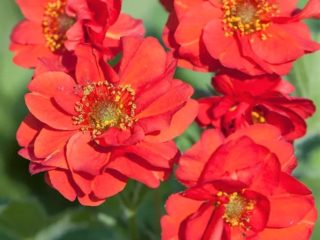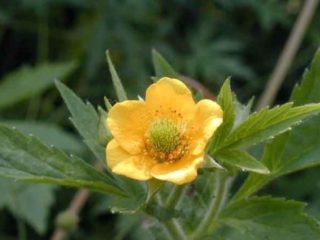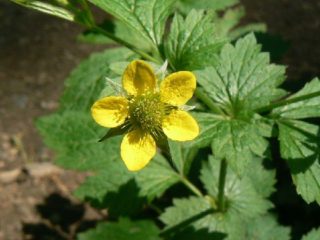Content
Chilean gravilat (Geum quellyon) is a herbaceous perennial from the Rosaceae family. Its other name is Greek rose. The homeland of the flowering plant is Chile, South America. Its luscious greenery, lush buds and long flowering period make it popular with gardeners around the world. Planting and caring for a Chilean gravilat is not particularly difficult. Subject to the simple rules of agricultural technology, the plant feels great in a temperate climate.
General description of the species
Chilean Gravilat is a magnificent garden flower with lush buds, serving as a real decoration of landscaped areas. The perennial belongs to medium-sized plants, reaches a height of 40 to 60 cm. The leaves are large, rounded-toothed, emerald green or grayish-marshy color. Velvety pubescent above and below. Located in a rosette at the very roots, on short cuttings.
The root is powerful, creeping, slightly branched. From it rises a long straight stem, pubescent with a short soft thief, tetrahedral. Weakly branched, with small toothed-cut leaves at the base of the shoots. The color can be green, reddish-brown, burgundy. At the ends, flower buds are formed, collected in a panicle or umbrella in inflorescences of 3-5 pieces.
Chilean gravilata flowers are large, up to 3-4 cm in diameter. Depending on the variety, they can be ordinary, with five petals, and lush, double. They resemble wild rose hips in shape. They have bright scarlet, burgundy, raspberry, yellow, orange, pale cream or pink color. Petals with a curly-wavy outer edge, in the center - a large "eye" with stamens of a yellowish-greenish color. It begins to bloom at the end of June and lasts 50-60 days. Some species delight with lush flowering throughout the summer. The fruit is a nutlet with cling hooks.
Popular varieties
Since 1824, when Chilean gravilat began to be cultivated, several dozen ornamental varieties have been bred. They all have their own characteristics, and also have an incredibly attractive appearance. Gardeners can only choose the most suitable plants for their site and climatic zone.
Gravilath Fireball
Gravilat Chilean Fireball is a medium-sized species, from 50 to 60 cm high. The flowers are bright red, luxuriantly double. The diameter is 3-4 cm. The leaves are collected in a rosette near the ground, and the stem branches strongly, giving many peduncles. The variety perfectly tolerates partial shade and summer short-term droughts, winter-hardy.
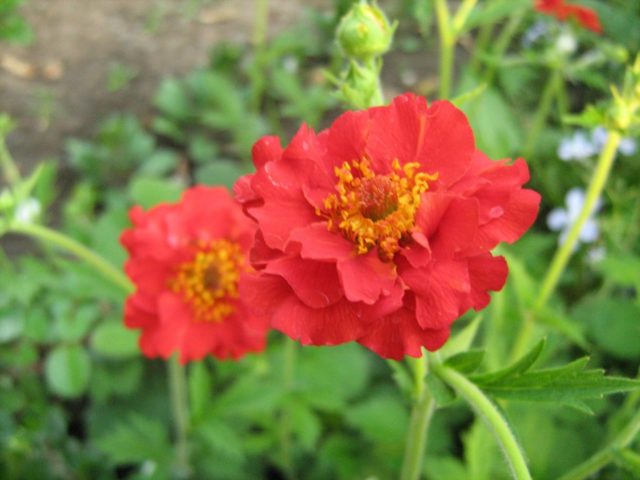
Spectacular flowering of Chilean gravilat "Fireball" lasts more than 50 days
Chilean Gravillat Moon Valley
Amazingly beautiful view with bright lemon or golden petals. Double or semi-double flowers have a diameter of 3-4 cm.Loves sunny places and regular watering. It goes well with red carnations and blue bells.
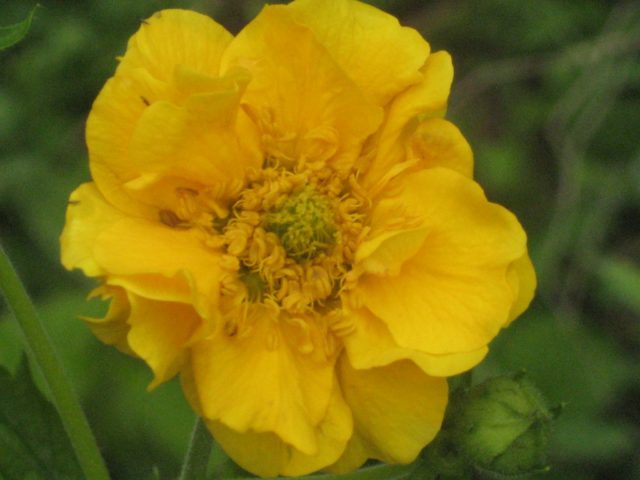
Gravilat "Moon Valley" has a straight stem up to 60 cm high and feathery, lyre-shaped leaves
Chilean gravillat Lady Strataden
Plant of the Lady Stratheden variety 50-60 cm tall, flowering time June-August. The variety is distinguished by the golden-lemon color of the petals. The flowers are large, 3 to 4 cm in diameter, lush. Unpretentious in care, while the flowering is bright, friendly.
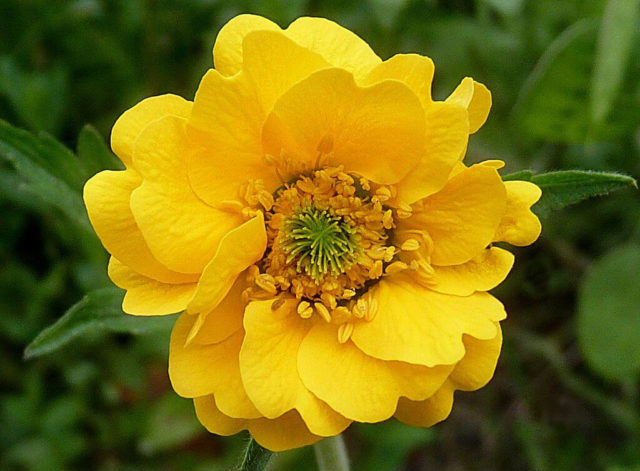
Lady Strataden loves mineral-rich soils
Chilean gravillat Gold Ball
The stems of the perennial Gold Ball reach a height of 60 cm. Bright yellow, elegantly sunny flowers delight with their appearance from May to August. The pinnate leaves are concentrated in the root part of the stem, and have a rich green color. A frost-resistant variety that perfectly withstands severe winters in the northern and mountainous regions.
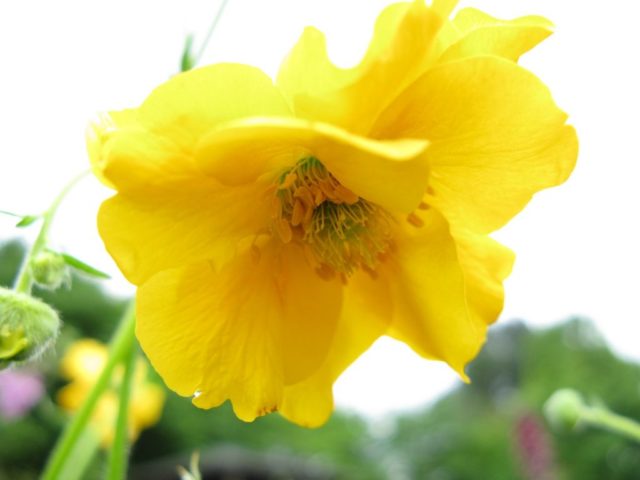
"Goldball" is one of the most preferred hybrids for the Russian climate
Chilean gravillat Mrs Bradshaw
Chilean Gravilat Mrs j Bradshaw is distinguished by large, double flowers of a rich, scarlet orange, almost scarlet color. Their diameter reaches 4 cm. The flowering period is July-August. Gravilat Chilean Mrs. Bradshaw is a winter-hardy variety that does not need shelter for the winter, tolerates low temperatures perfectly.
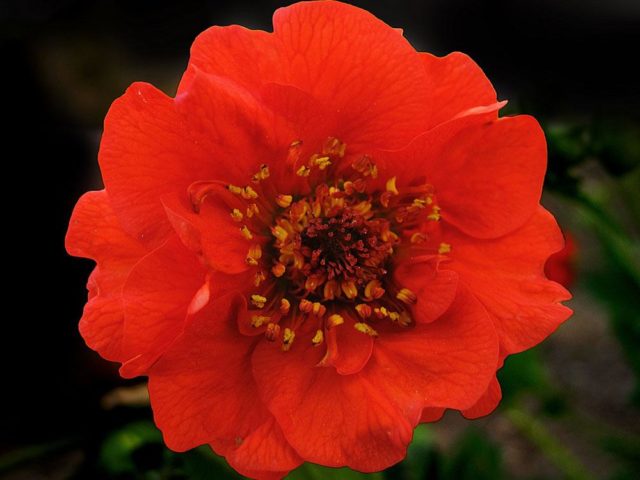
Mrs Bradshaw's variety is one of the tallest, reaching 80 cm
Chilean Gravillat Blazing Sunset
Spectacular, profusely flowering type of Blazing Sunset gravilates with bright red, white or crimson lush inflorescences. Plant height is 60 cm, flower diameter is 3 cm. The flowering period is from June to August. It winters well without additional shelter. Gratefully responds to feeding with wood ash.
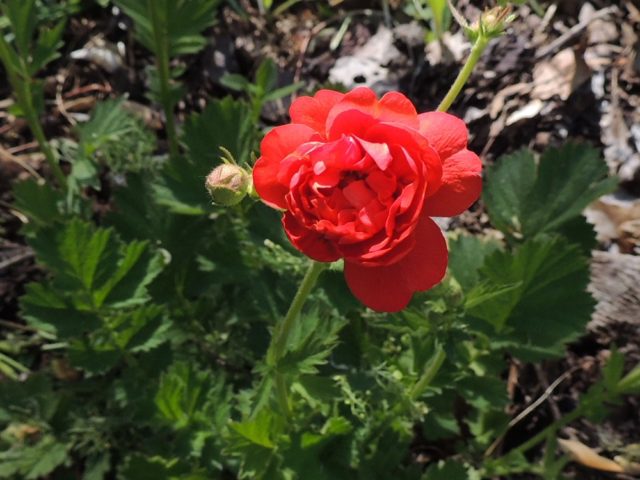
The variety can grow both in open sunny places and in partial shade.
Chilean gravillat Rigoletto
Rigoletto bushes are medium-sized, grow up to 60 cm.The variety is distinguished by large, bright red double buds. The petals are rounded-wavy, the core is dark or green-brown, with rich yellow stamens.
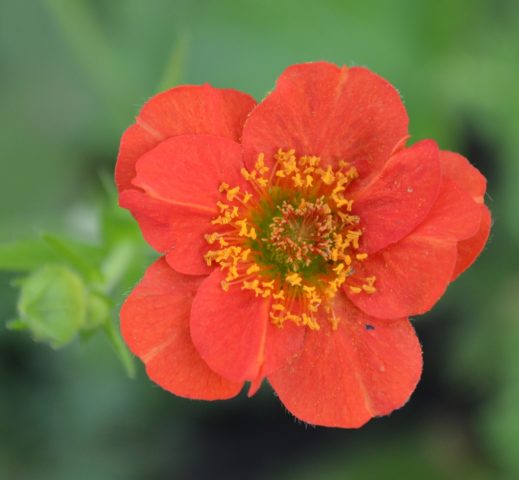
Chilean gravilat "Rigoletto" is one of the most popular varieties
Chilean gravillat Mai Tai
Geum hybride Mai Tai is medium-sized, from 40 to 50 cm. It has openwork carved malachite leaves. Single flowers are lush, double, pink-cream or orange.
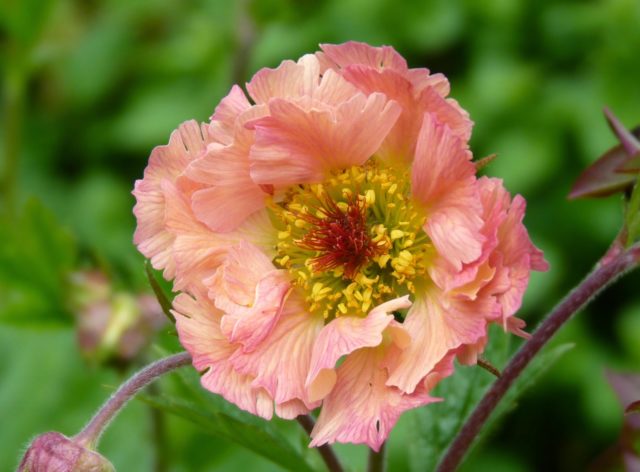
Gravilat "Mai Tai" looks great next to other flowering plants, lianas, mosses
Aurelia
Aurelia is a very beautiful variety with large double buds of golden hue. Bushes up to 60 cm high, straight or slightly bent under the weight of inflorescences. Flowering begins in June.
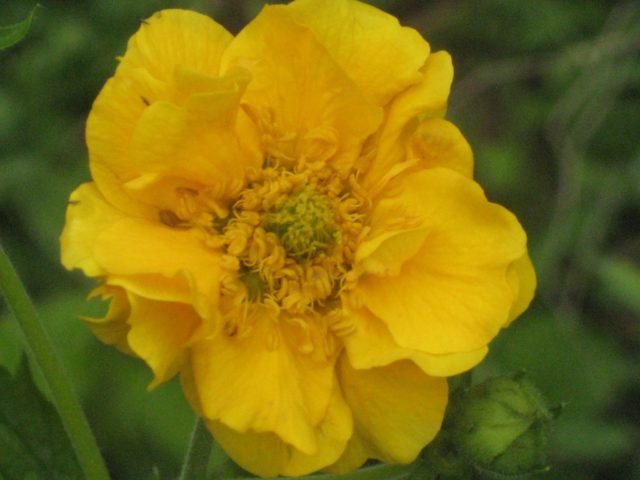
Amazingly beautiful, sunny flowers give a great mood throughout most of the summer
Application in landscape design
Chilean gravilat is widely used to decorate house plots, organize flower beds in city parks, along roads and in squares. Perennial looks great in rockeries. It is planted on alpine slides, ridges and mixborders. One of the most successful options for flowering plantings in alleys, in front gardens and green lawns. They are framed by natural and artificial reservoirs - ponds, streams, rivers, pools.
The flower is beautiful in individual compositions. With the correct selection of several varieties, continuous flowering can be organized from May to September. The most successful combinations are with carnations, bells, phlox, peonies. Chilean Gravilat is beautiful in landscape design, which can be seen in the photo.
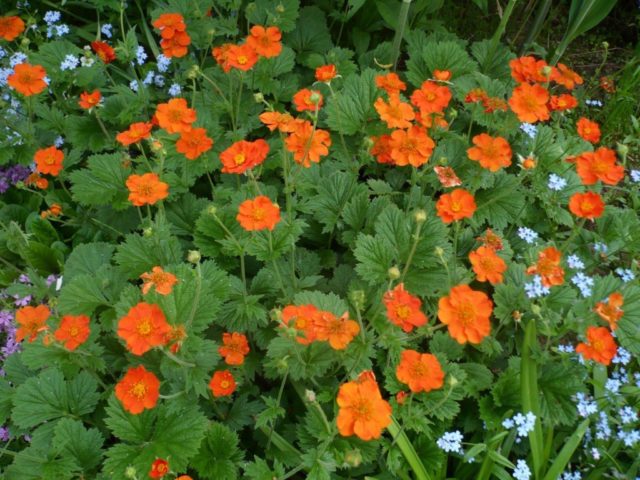
Chilean gravilat goes well with most ornamental plants
Breeding features
Chilean gravilat can be propagated by seeds, which are harvested in the fall, when they are finally ripe. They can be planted in spring or late summer.
The second way is to divide the bush, but no more than four times a season. Overgrown bushes should be carefully dug in and the rosettes with part of the roots should be separated.All parts must be planted immediately to a permanent place, keeping a distance.
Growing seedlings of the Chilean gravilata
Cultivation of all types of gravilat, including the "Fireball", from seeds has its own specifics. Sowed in March, in the southern regions - in February. They should be previously kept at a temperature of 2-5 degrees, soaked, thus increasing the percentage of germination. For soaking, a solution of "Epin" or another biostimulant is perfect.
Nutritious light soil with a neutral or slightly alkaline reaction (can be purchased ready-made in a specialized store or prepared from turf, peat, sand and humus with the addition of wood ash) to be laid out in boxes. Make grooves or make 2-3 cm depressions, lay out the swollen seeds. Sprinkle with soil, cover with glass or foil. Watering is done as needed. Dive seedlings when three true leaves appear in separate pots.
If the site on which the Chilean gravilat is planned to be planted is low, then the beds must be raised by at least 0.5 m, and also provide good drainage. Perennial does not like stagnant water and marshy, heavy clay soils.
Planting and caring for a Chilean gravilat in the open field
Chilean gravilat is an unpretentious plant. It does not require special skills from the owners of the site or an anxious look at each bush. That is why the perennial is so loved by flower growers. Observing the rules of planting and care, you can achieve an impressive result in one season. Landing on the site and caring for the Fireball gravitator is not so difficult.
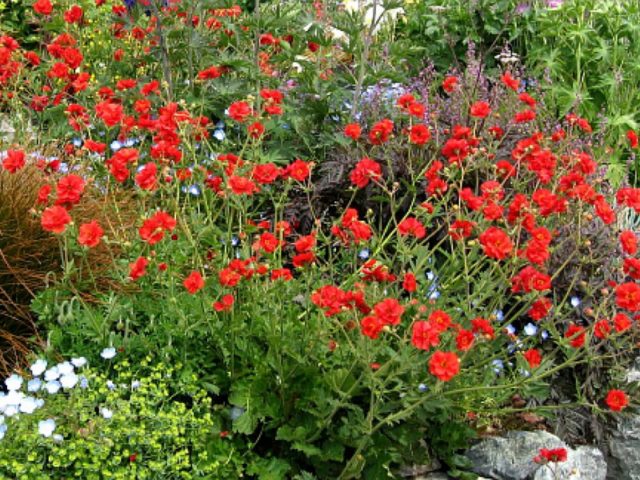
The combination of wild stone, bright scarlet Chilean gravilata and pale blue anagallis, mesmerizes the eye
Landing terms and rules
Chilean gravilat is sown with seeds in the soil in early spring, as soon as the soil warms up a little. The garden bed prepared in the fall is additionally leveled and loosened, you can add ash or slaked lime, well rotted humus. Then it is necessary to moisten the soil and make grooves at a distance of 15-25 cm from each other. Plant seeds, level the surface. Watering is done as needed. As soon as shoots appear, they are thinned out, leaving the strongest specimens.
Seedlings are planted in a permanent place in May, as soon as the threat of frost has passed. 2 weeks before planting, the plants must be taken outside, hardening. They make holes deep enough in the soil to place an earthen lump. It is better if the plants are planted in individual peat glasses - this way they will root more successfully. Chilean gravilat in a flowerbed looks amazing not only in the photo.
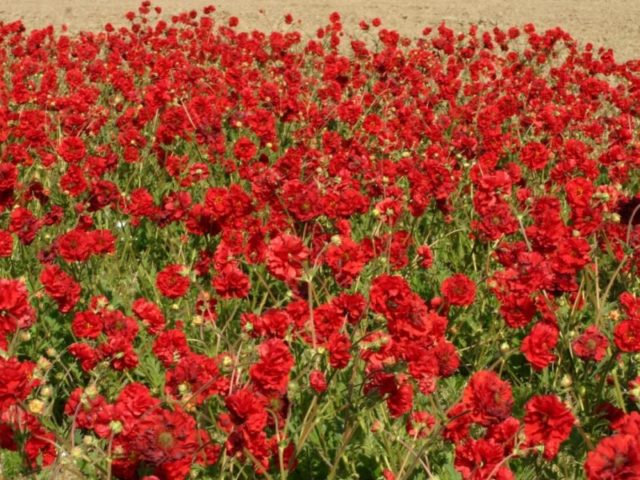
A bright, elegant carpet of lush buds - this is what the site with Chilean gravilats looks like
Watering and feeding schedule
Before planting seedlings or seeds, fertilizers should be applied to the soil:
- biohumus, humus, compost, peat, wood ash;
- mineral complexes sold in the store, according to the specified standards.
In the future, once a year, planting can be fed with an infusion of ash, diluted manure or universal fertilizer. If the soil is depleted, then feeding is done twice - at the beginning of the growing season and during flowering.
Watering should be moderate, except during the summer drought. Adult bushes should be watered 1-2 times a week.
Loosening
After watering, the Chilean gravilat must be loosened, simultaneously removing weeds and perennial roots. Then add mulch - sawdust, chopped bark, chopped straw or peat.
Pruning
In order for the Chilean gravilat to delight with its beautiful flowers as long as possible, faded buds must be removed immediately. Cut off the withered leaves, dead sections of the stems.
Wintering
Usually Chilean gravilat does not need special preparation for winter. It is quite resistant to frost, and in the presence of a high snow cover it perfectly tolerates the most severe cold. Terry, highly decorative varieties can be closed for the winter, and shelter is also required in the absence of snow. Fallen dry foliage, chopped straw, spruce branches are suitable.
Diseases and pests
Chilean gravilat is resistant to most ailments of garden flowers. But improper care of plants can provoke the development of diseases. Excessive watering, rainy summers, waterlogged soils and thickened plantings negatively affect the health of the bushes. If root rot occurs, the affected specimens must be uprooted, and the remaining ones must be urgently treated with fungicides.
In a drought, in case of rare watering, a perennial can be affected by a spider mite. It is necessary to carry out treatment with any specialized insecticide, provide moisture.
Conclusion
Planting and caring for a Chilean gravilat is not a big deal, even for novice florists. An unpretentious plant responds with gratitude to the introduction of ash into the soil, liming and timely watering. It pleases the eye with abundant flowering for one and a half to two months. With proper care, it is practically not susceptible to diseases and pests. Perennial does not require shelter for the winter. The exception is delicate terry varieties and frosty winters with little snow. In this case, it is better to cover the plants.
